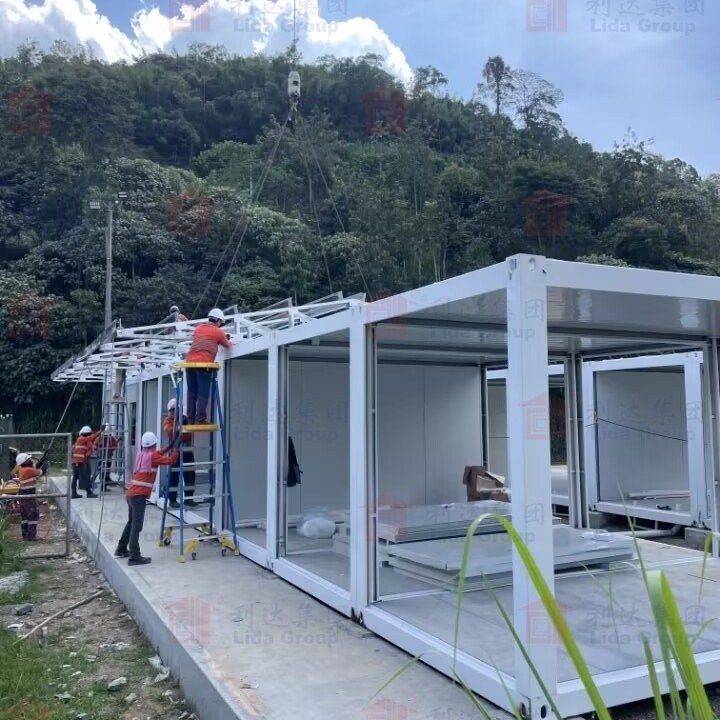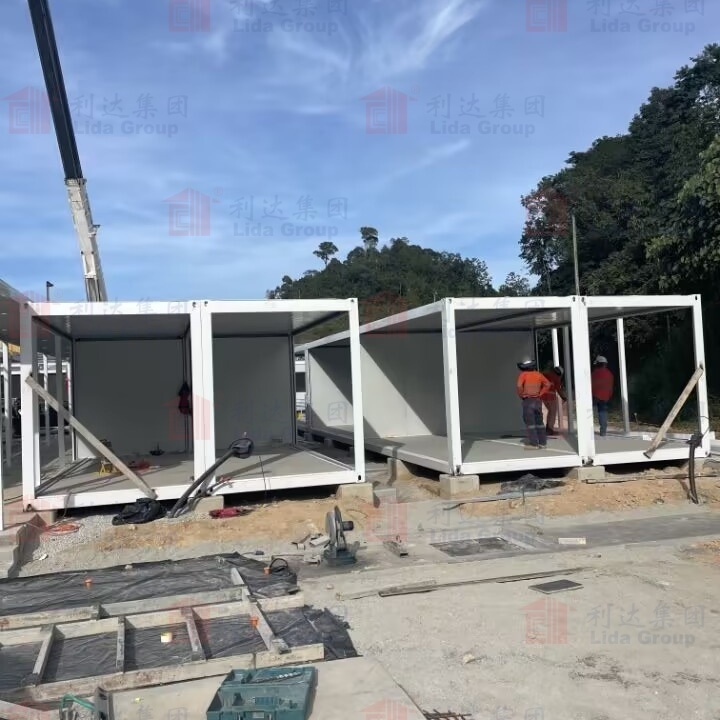Tel: 0086-532-88966982
0086-532-88965892
Website: www.lidajituan.com
E-mail: sales@lidajituan.com
Head office: 5th Floor, Building A, Darron Center, 180 Haier Road, Qingdao, 266000, China
Flat Pack vs Modular Container Buildings: Which Construction Saves More?
Classification:Company News
Release time:2025-06-03 00:00
Flat Pack vs Modular Container Buildings: Which Construction Saves More?
In the race to balance cost, speed, and sustainability, two innovative construction methods have emerged as frontrunners: flat pack container systems and modular container buildings. Both leverage the efficiency of prefabrication, but their approaches differ dramatically—and so do their savings potential. For developers, architects, and businesses eyeing container house projects, the choice between these methods can mean saving thousands of dollars or losing weeks to logistical headaches.
As a China supplier with 30+ years of expertise, Lida Group has mastered both techniques, delivering everything from office container complexes to disaster-resilient steel structure buildings. In this no-nonsense comparison, we break down which method saves more money, time, and hassle—and when to choose one over the other.
The Basics: What’s the Difference?
1. Flat Pack Container Buildings
- Definition: Pre-cut, disassembled components (walls, roofs, floors) shipped in kits for onsite assembly.
- Best For: Remote sites, DIY projects, or tight budgets.
- Example: A 40ft flat pack container house from Lida Group includes numbered panels, insulation, and step-by-step AR guides.
2. Modular Container Buildings
- Definition: Fully assembled modules (e.g., complete rooms) transported and connected onsite.
- Best For: Urban developments, tight deadlines, or high-end finishes.
- Example: Lida’s pre-wired office container units with installed HVAC and plumbing.

Cost Showdown: Where the Savings Add Up
1. Material Costs
- Flat Pack: Wins for raw affordability.
- Savings: 15–25% cheaper than modular due to compact shipping and DIY labor.
- Lida Group’s Pricing: A 20ft basic flat pack kit starts at $8,500 FOB China.
- Modular: Higher due to factory labor and pre-installed systems.
- Average Cost: 25,000 per 20ft unit.
2. Labor Expenses
- Flat Pack: Requires 40–60 hours of onsite labor (ideal for low-wage regions).
- Catch: DIY errors can inflate costs by 10–15%.
- Modular: Minimal onsite work (5–10 hours per unit).
- Lida Group’s Edge: Robotic welding in factories cuts labor costs by 30%.
3. Shipping & Logistics
- Flat Pack: Ships 50% more units per container, reducing freight costs.
- Case Study: A Kenyan school project saved $12,000 on shipping 100 flat pack classrooms vs modular.
- Modular: Bulky modules limit shipping efficiency but save assembly time.
Verdict: Flat pack saves more upfront; modular saves on skilled labor and timelines.
Time Efficiency: Speed vs Simplicity
1. Production Lead Time
- Flat Pack: 2–4 weeks (simple designs).
- Modular: 4–8 weeks (complex electrical/plumbing integration).
2. Onsite Assembly
- Flat Pack: 1–3 weeks for a 40ft unit (DIY or local crew).
- Modular: 1–3 days per unit (crane lifting and bolting).
Real-World Example:
- Flat Pack: A 50-unit container house project in rural India took 14 weeks (10 weeks production + 4 weeks assembly).
- Modular: A 50-unit modular house complex in Dubai took 12 weeks (8 weeks production + 4 days assembly).
Verdict: Modular is faster overall but demands higher upfront planning.
Customization & Flexibility
1. Design Freedom
- Flat Pack: Ideal for unique layouts; walls/roofs can be modified onsite.
- Lida Group’s OEM Service: Clients can tweak window placements or insulation thickness pre-production.
- Modular: Limited to module dimensions (typically 8ft x 40ft) but offers high-end finishes.
2. Scalability
- Flat Pack: Easier to expand incrementally (add rooms one-by-one).
- Modular: Requires pre-planned module connections for multi-story builds.
Innovation Spotlight:
Lida Group’s hybrid approach—using flat pack panels to connect modular units—enables cost-effective expansions like this 3-story steel structure building in Vietnam.
Durability & Longevity
- Flat Pack: Joint quality depends on onsite workmanship. Proper sealing is critical in humid climates.
- Modular: Factory welding ensures consistent durability. Lida’s modules withstand 150 mph winds and 8.5-magnitude quakes.
Pro Tip: Opt for modular in disaster-prone areas and flat pack for stable, dry climates.
Sustainability Face-Off
- Flat Pack:
- ✅ Lower carbon footprint (lightweight shipping).
- ✅ 70% less material waste vs traditional construction.
- Modular:
- ✅ Energy-efficient due to precision insulation.
- ✅ 95% recyclable steel content in Lida’s units.
When to Choose Flat Pack or Modular
Flat Pack Container Buildings Are Better If You…
- Have a tight budget (<$15k per unit).
- Operate in remote areas with cheap local labor.
- Need flexible, phased construction.
- Prioritize shipping efficiency over speed.
Modular Container Buildings Are Better If You…
- Require rapid deployment (e.g., emergency housing).
- Want high-end finishes (pre-installed plumbing, smart tech).
- Lack skilled onsite labor.
- Are building in harsh climates.

Lida Group’s Expertise: Bridging Both Worlds
Since 1993, Lida Group has delivered 10,000+ projects using both methods, including:
- Flat Pack: 200+ office container units for a Nigerian oil field, assembled locally with 30% cost savings.
- Modular: A 120-unit modular house complex in Chile, installed in 18 days post-earthquake.
Why Clients Trust Lida:
- Wholesale Pricing: 5–15% discounts on 50+ unit orders.
- OEM Flexibility: Customize everything from door hinges to electrical loads.
- Global Logistics: Door-to-door delivery with compliance guarantees.
Future Trends: The Best of Both Methods
AI-Optimized Flat Pack Kits
Algorithms will generate panel layouts to minimize waste (e.g., Lida’s pilot project cut material use by 12%).
Modular-Flat Pack Hybrids
Partially assembled modules with flat pack connectors for easier expansion.
Robotic Onsite Assembly
Drones and robots to erect flat pack units, reducing labor dependency.
Conclusion: Your Savings Depend on Priorities
There’s no one-size-fits-all answer. Flat pack container buildings shine for budget-driven, flexible projects, while modular container buildings prioritize speed and durability. As a leading China supplier, Lida Group offers both solutions, ensuring you get maximum savings without compromising quality.
Ready to optimize your project? Contact Lida Group today for a free cost-benefit analysis tailored to your needs.
office container,modular house,flat pack container,constructions
Contact Us
Head Office: 5th Floor,Building A,Darron Center,No.180,Haier Road,Qingdao, 266000,China
Tel: 0086-532-88966982 88965892 Fax:0086-532-88965571
WhatsApp:+86 13793209022
Mobile/Wechat:+86-15166671720
Email: sales@lidajituan.com Website: www.lidajituan.com
Alternate Website: www.lidamodularhouse.com
Head Office: 5th Floor,Building A,Darron Center,No.180,Haier
Road,Qingdao, 266000,China
Tel: 0086-532-88966982 88965892
Fax:0086-532-88965571
Email: sales@lidajituan.com
Website: www.lidajituan.com
Alternate Websit: www.prefabhousecn.com
Wechat/WhatsApp:+86-13793209022
Copyright(c)2023 All Rights Reserved SEO Business license

